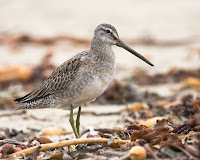LONG-BILLED DOWITCHER
LONG-BILLED DOWITCHER (Limnodromus scolopaceus) – (See images below)
DESCRIPTION: The Long-Billed Dowitcher, as its name
implies, has a straight, thin dark grey bill that is twice as long as its head. The head is beige with a brown bar across the eyes and a brown cap. The breeding plumage is cinnamon for the breast and under parts. There is a white patch on the lower back, visible in flight. The top parts are mottled brown. In the winter the cinnamon color is replaced by grey. The legs are grey-olive. Sexes are similar. The bird measures around 11 inches (28 cm) long.
VOICE: https://www.xeno-canto.org/species/Limnodromus-scolopaceus
NAME: The name ‘Dowitcher’ derives from German and
refers to a snipe. The Latin genus name ‘Limnodromus’ comes from Greek ‘limne’ which means ‘marsh’, and ‘dromos’ which means ‘running’. The Latin species name ‘scolopaceus’ means ‘snipe or woodcock-like’.
HABITAT: Tundra wetlands.
DIET: Forages in shallow water or mud for invertebrates,
probing with their long bill in a sewing machine fashion.
NESTING: the nest is built near water in a shallow
depression, and the bottom can be damp even if lined with plant material. As soon as they are born chicks are able to walk and on their own – not fed by their parents.
DISTRIBUTION: Breeding range includes Arctic coast of
Alaska and western Canada, and of Siberia. During migration they can be found in North America on the west side, also on islands in the Pacific such as Hawaii.
DISTRIBUTION MAP: https://en.wikipedia.org/wiki/Long-billed_dowitcher#/media/File:Limnodromus_scolopaceus_map.svg
ON PEI: There has been occasional sightings of the long-billed dowitcher on Prince Edward Island in the summer, which turned to rare in the fall. This occurred during their migration, as this bird does not breed on the island.
CONSERVATION: Population estimated at around 500,000
by the Canadian Wildlife Service (see birdweb reference below). Used to be hunted but now protected. Listed as ‘least concern’, but habitat loss and environmental contaminants are threats.
SIMILAR SPECIES: Very similar to the Short-billed Dowitcher. The two species have different ranges however – the long-billed one on the west side of North America and the short-billed one on the east side. Identification can be difficult when found in the same region, but their vocalizations are different.
REFERENCES: https://en.wikipedia.org/wiki/Long-billed_dowitcher
https://www.allaboutbirds.org/guide/Long-billed_Dowitcher/id
https://www.audubon.org/field-guide/bird/long-billed-dowitcher
http://www.birdweb.org/birdweb/bird/long-billed_dowitcher
https://www.mbr-pwrc.usgs.gov/id/framlst/i2320id.html
http://www.nhptv.org/natureworks/longbilldow.htm (New Hampshire PBS)
The video below shows a long-billed dowitcher (as a silhouette) self-preening with two ruddy turnstones nearby (location: Jame Campbell National Wildlife Refuge, Oahu, Hawaii).
DESCRIPTION: The Long-Billed Dowitcher, as its name
implies, has a straight, thin dark grey bill that is twice as long as its head. The head is beige with a brown bar across the eyes and a brown cap. The breeding plumage is cinnamon for the breast and under parts. There is a white patch on the lower back, visible in flight. The top parts are mottled brown. In the winter the cinnamon color is replaced by grey. The legs are grey-olive. Sexes are similar. The bird measures around 11 inches (28 cm) long.
VOICE: https://www.xeno-canto.org/species/Limnodromus-scolopaceus
NAME: The name ‘Dowitcher’ derives from German and
refers to a snipe. The Latin genus name ‘Limnodromus’ comes from Greek ‘limne’ which means ‘marsh’, and ‘dromos’ which means ‘running’. The Latin species name ‘scolopaceus’ means ‘snipe or woodcock-like’.
HABITAT: Tundra wetlands.
DIET: Forages in shallow water or mud for invertebrates,
probing with their long bill in a sewing machine fashion.
NESTING: the nest is built near water in a shallow
depression, and the bottom can be damp even if lined with plant material. As soon as they are born chicks are able to walk and on their own – not fed by their parents.
DISTRIBUTION: Breeding range includes Arctic coast of
Alaska and western Canada, and of Siberia. During migration they can be found in North America on the west side, also on islands in the Pacific such as Hawaii.
DISTRIBUTION MAP: https://en.wikipedia.org/wiki/Long-billed_dowitcher#/media/File:Limnodromus_scolopaceus_map.svg
ON PEI: There has been occasional sightings of the long-billed dowitcher on Prince Edward Island in the summer, which turned to rare in the fall. This occurred during their migration, as this bird does not breed on the island.
CONSERVATION: Population estimated at around 500,000
by the Canadian Wildlife Service (see birdweb reference below). Used to be hunted but now protected. Listed as ‘least concern’, but habitat loss and environmental contaminants are threats.
SIMILAR SPECIES: Very similar to the Short-billed Dowitcher. The two species have different ranges however – the long-billed one on the west side of North America and the short-billed one on the east side. Identification can be difficult when found in the same region, but their vocalizations are different.
REFERENCES: https://en.wikipedia.org/wiki/Long-billed_dowitcher
https://www.allaboutbirds.org/guide/Long-billed_Dowitcher/id
https://www.audubon.org/field-guide/bird/long-billed-dowitcher
http://www.birdweb.org/birdweb/bird/long-billed_dowitcher
https://www.mbr-pwrc.usgs.gov/id/framlst/i2320id.html
http://www.nhptv.org/natureworks/longbilldow.htm (New Hampshire PBS)
 |
| Long-billed dowitcher, breeding plumage Barrow, AK, by Alan D. Wilson |
 |
| Long-billed dowitcher, Michael ‘Mike’ L. Baird |
The video below shows a long-billed dowitcher (as a silhouette) self-preening with two ruddy turnstones nearby (location: Jame Campbell National Wildlife Refuge, Oahu, Hawaii).